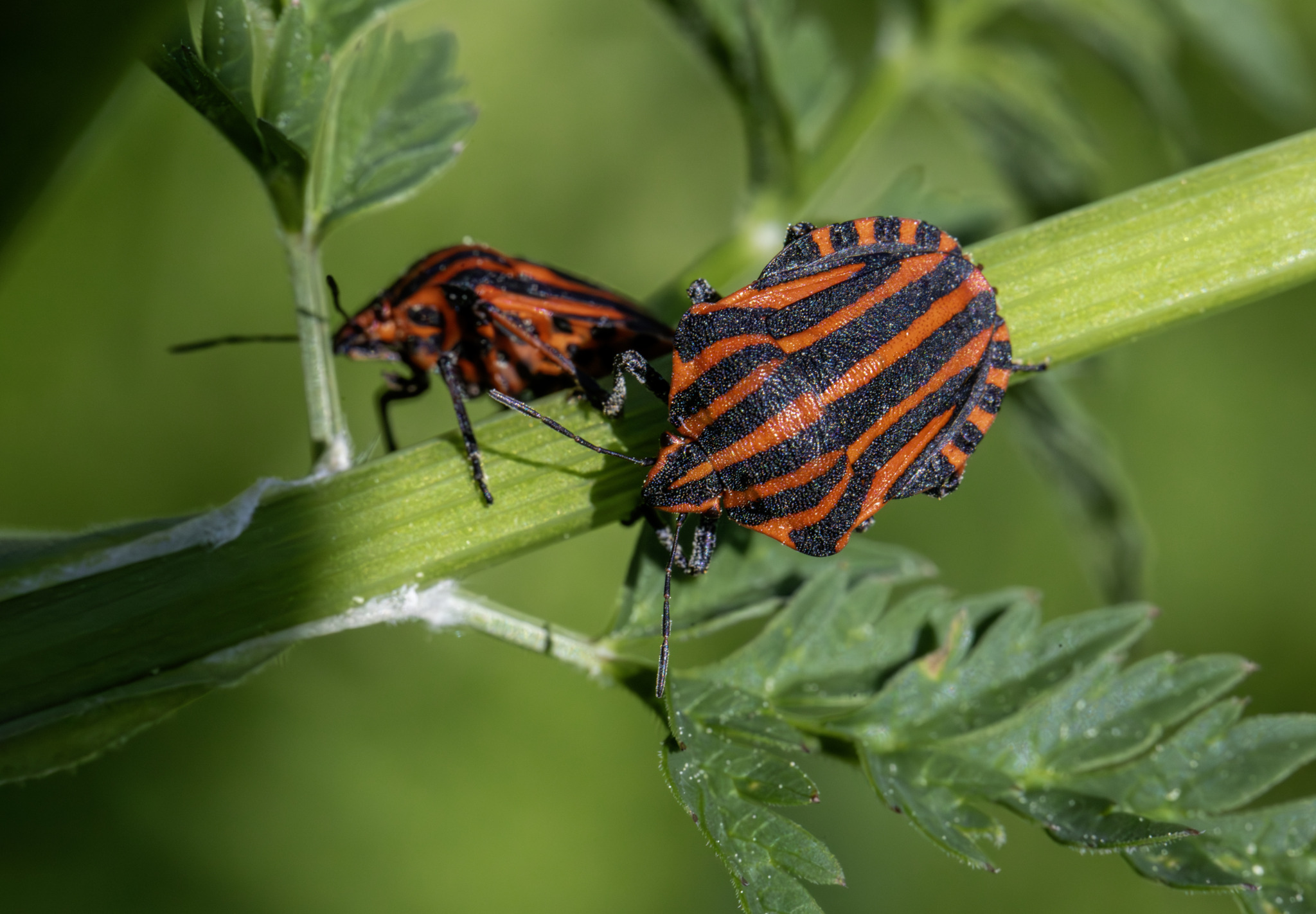Here’s a full overview of the Italian striped-bug (Graphosoma lineatum), a striking shieldbug often seen on sunny grasslands:
Italian Striped-bug (Graphosoma lineatum)
Taxonomy & Classification
- Kingdom: Animalia
- Phylum: Arthropoda
- Class: Insecta
- Order: Hemiptera (true bugs)
- Family: Pentatomidae (shieldbugs/stink bugs)
- Genus: Graphosoma
- Species: G. lineatum
General Description
The Italian striped-bug, also called the minstrel bug or striped shieldbug, is instantly recognizable by its bold red-and-black stripes.
- Size: 8–12 mm long.
- Coloration:
- Dorsal surface bright red or orange with black longitudinal stripes across the pronotum and elytra (wing covers).
- Legs and antennae mostly black, sometimes with reddish joints.
- Underside patterned with alternating black and red patches.
- Shape: Classic shield-shaped body, slightly rounded.
- Sexual Dimorphism: Minimal; males are often a bit smaller and narrower than females.
Behavior & Lifestyle
- Feeding:
- Plant sap feeder; prefers umbellifer plants (Apiaceae) such as wild carrot (Daucus carota), fennel, dill, and parsnip.
- Uses piercing-sucking mouthparts to feed on stems, leaves, and seeds.
- Activity:
- Adults are most active in summer (June–August), often seen basking on flower heads.
- Gregarious; many individuals may gather on a single plant.
- Defense:
- Emits a strong odor from thoracic scent glands when threatened.
- Aposematic coloration (red/black stripes) warns predators of unpalatability.
Habitat
- Prefers sunny, dry grasslands, meadows, roadsides, and field edges.
- Strongly associated with habitats rich in Apiaceae, on which it feeds and lays eggs.
Geographic Range
- Native Distribution: Southern and central Europe, extending into North Africa and western Asia.
- Northward Spread: In recent decades, it has expanded into central and northern Europe due to climate warming.
- Localized Abundance: Very common in Mediterranean regions.
Life Cycle
- Eggs: Deposited in clusters on host plants.
- Nymphs: Five instars, resembling adults but smaller and without full wing development.
- Adults: Overwinter in leaf litter or under bark, re-emerging in spring.
- Generations: Typically one per year (univoltine).
Ecological Role
- Plant Interactions: Feeds heavily on umbellifers, sometimes reducing seed set.
- Prey for Predators: Despite aposematic coloration, still preyed upon by birds, spiders, and assassin bugs.
- Indicator Species: Presence often signals healthy, sunny meadows with abundant wildflowers.
Special Adaptations
- Aposematism: Bright warning stripes protect it from predation.
- Scent Glands: Chemical defense deters insectivores.
- Aggregation Behavior: Group living on flower heads enhances visibility of warning signals.
Conservation Status
- IUCN Status: Not globally assessed, but considered common and stable.
- Threats:
- Habitat loss through intensive agriculture.
- Use of pesticides in farmland areas.
- Conservation Needs: Maintaining wildflower meadows and uncultivated field margins.
Interesting Facts
- Sometimes confused with the closely related Graphosoma italicum; many authors treat them as the same species.
- Its bold stripes resemble a prison uniform or minstrel’s costume, hence its nickname “minstrel bug.”
- Like many shieldbugs, it produces a pungent odor if handled.
- Unlike many predatory shieldbugs, this species is strictly herbivorous.
Visited 888 times, 18 visit(s) today
Views: 3396
Subscribe to the newsletter:
